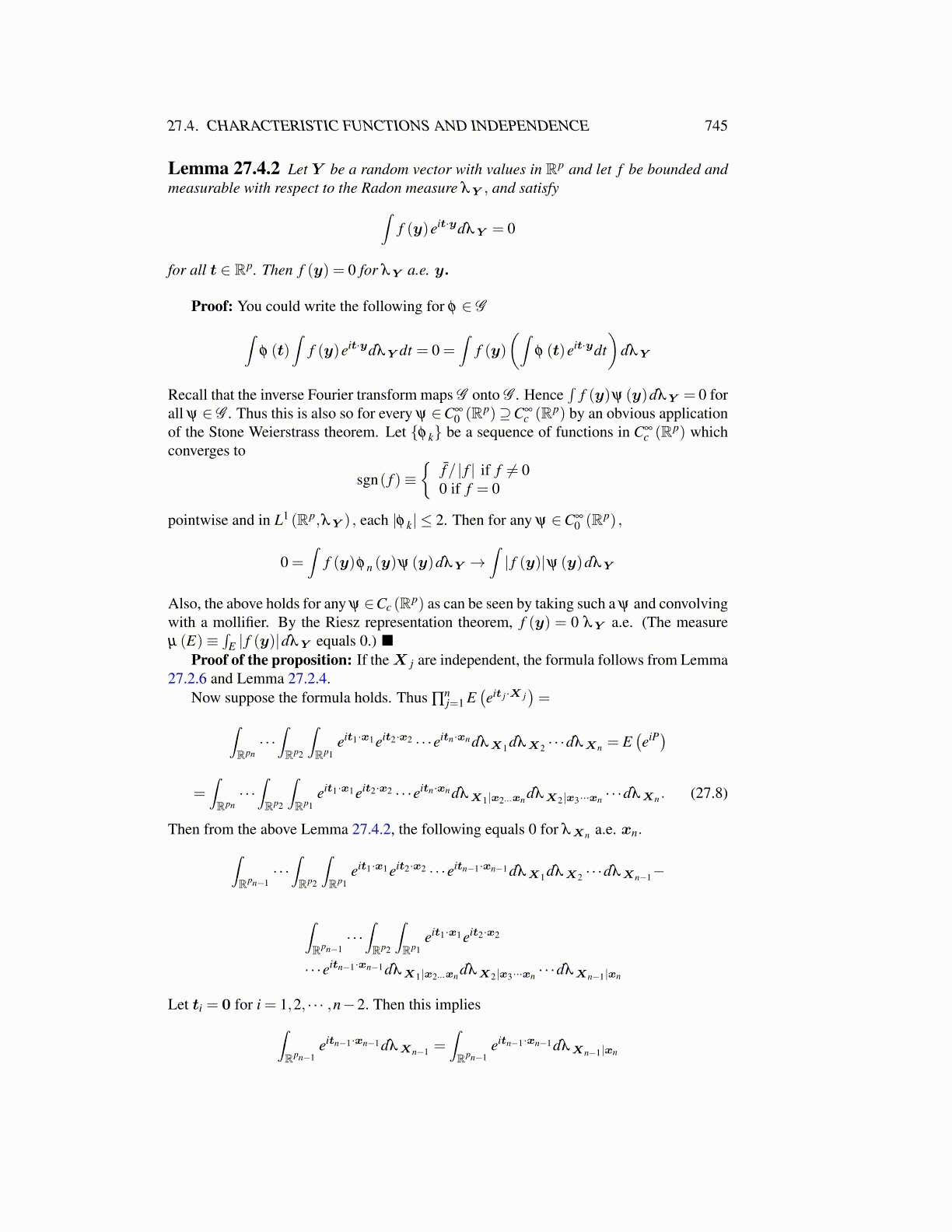
27.4. CHARACTERISTIC FUNCTIONS AND INDEPENDENCE 745
Lemma 27.4.2 Let Y be a random vector with values in Rp and let f be bounded andmeasurable with respect to the Radon measure λY , and satisfy∫
f (y)eit·ydλY = 0
for all t ∈ Rp. Then f (y) = 0 for λY a.e. y.
Proof: You could write the following for φ ∈ G∫φ (t)
∫f (y)eit·ydλY dt = 0 =
∫f (y)
(∫φ (t)eit·ydt
)dλY
Recall that the inverse Fourier transform maps G onto G . Hence∫
f (y)ψ (y)dλY = 0 forall ψ ∈ G . Thus this is also so for every ψ ∈C∞
0 (Rp)⊇C∞c (Rp) by an obvious application
of the Stone Weierstrass theorem. Let {φ k} be a sequence of functions in C∞c (Rp) which
converges to
sgn( f )≡{
f̄/ | f | if f ̸= 00 if f = 0
pointwise and in L1 (Rp,λY ) , each |φ k| ≤ 2. Then for any ψ ∈C∞0 (Rp) ,
0 =∫
f (y)φ n (y)ψ (y)dλY →∫| f (y)|ψ (y)dλY
Also, the above holds for any ψ ∈Cc (Rp) as can be seen by taking such a ψ and convolvingwith a mollifier. By the Riesz representation theorem, f (y) = 0 λY a.e. (The measureµ (E)≡
∫E | f (y)|dλY equals 0.) ■
Proof of the proposition: If theX j are independent, the formula follows from Lemma27.2.6 and Lemma 27.2.4.
Now suppose the formula holds. Thus ∏nj=1 E
(eit j ·X j
)=∫
Rpn· · ·∫Rp2
∫Rp1
eit1·x1eit2·x2 · · ·eitn·xndλX1dλX2 · · ·dλXn = E(eiP)
=∫Rpn· · ·∫Rp2
∫Rp1
eit1·x1 eit2·x2 · · ·eitn·xndλX1|x2···xndλX2|x3···xn · · ·dλXn . (27.8)
Then from the above Lemma 27.4.2, the following equals 0 for λXn a.e. xn.∫Rpn−1
· · ·∫Rp2
∫Rp1
eit1·x1eit2·x2 · · ·eitn−1·xn−1dλX1dλX2 · · ·dλXn−1−
∫Rpn−1
· · ·∫Rp2
∫Rp1
eit1·x1eit2·x2
· · ·eitn−1·xn−1dλX1|x2···xndλX2|x3···xn · · ·dλXn−1|xn
Let ti = 0 for i = 1,2, · · · ,n−2. Then this implies∫Rpn−1
eitn−1·xn−1dλXn−1 =∫Rpn−1
eitn−1·xn−1dλXn−1|xn